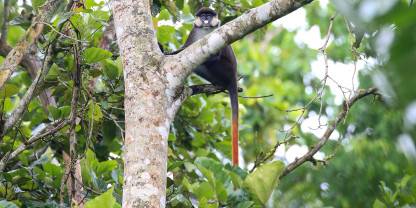Founded in 1992, Bigodi Wetland Sanctuary is a model of successful community-based ecotourism. A guided walking trail here offers an opportunity to see a wealth of forest-edge birds and monkeys associated with bordering Kibale National Park. The sanctuary is run by an NGO called Kibale Association for Rural and Environmental Development (KAFRED) and doubles as a training center for bird guides who work all over Uganda.

-
Best Time To Go
- January to February and June to July (Trails are driest)
-
High Season
- June to September (Peak time for Uganda)
-
Size
- 2km² / 0.77mi²
-
Altitude
-
1,250-1,300m /4,101-4,265ft
 View Photos
View Photos
 View Photos
+11
Photos
View Photos
+11
Photos
Pros & Cons
- Some of the best forest birding in Uganda
- Exceptional standard of guiding
- Several localized swamp birds might be seen from a wooden boardwalk
- Great add-on to at bordering Kibale National Park
- Up to six primate species might be seen on one walk
- The wetland trail can be extended to include a community visit
- Affordably priced
- Profits support local community development projects
- The trail can be muddy and may require gum boots (provided for free at reception)
- There is some encroachment and deforestation on the swamp fringes
- Big Five are absent, though elephant might pass through occasionally
Wildlife
Many of the 13 primate species listed for Kibale are regular visitors to Bigodi. Most common is the Ugandan red colobus, but you might also see black-and-white colobus, Uganda mangabey, red-tailed monkey, L’Hoest’s monkey and . Chimpanzees pass through occasionally, while resident antelope include bushbuck and the secretive sitatunga. Among the more visible and spectacular of 200-plus recorded bird species are great blue turaco, Ross’s turaco, yellow-billed barbet, blue-throated roller and papyrus gonolek.
Scenery
Although Bigodi Wetland Sanctuary isn’t scenic in a conventional sense, it does boast a compelling and memorable tropical jungle atmosphere. The lush swamp at the sanctuary’s heart is dense with papyrus and reed beds, and it is fringed by a combination of palm trees and tropical rainforest.
Activities
The main activity at Bigodi is guided walks along a 4.5km/2.8mi foot trail. The bird guides here are very keen and knowledgeable. Over the course of an outing, you can expect to see around 30 colorful forest-edge bird species along with several types of monkey. The trail incorporates a wooden boardwalk that runs through the heart of a papyrus swamp inhabited by papyrus gonolek and white-spotted flufftail. The trail can be extended to include a visit to a traditional healer and community elders.
Weather & Climate
Bigodi Wetland Sanctuary has a warm equatorial climate with little seasonal variation and a typical daily maximum of around 26°C/79°F. Rainfall is possible throughout the year but lowest in January, February, June and July. The climate is broadly similar to neighboring Kibale National Park. More info:
Best Time To Visit
The key bird species at Bigodi are resident and the sanctuary is rewarding at all times of year. If you plan to track chimps at Kibale, that is also a year-round activity. However, the drier months of January, February, June and July offer the best conditions underfoot.
How To Get to Bigodi Wetland
Bigodi Wetland Sanctuary borders Kibale National Park, about 37km/23mi southeast of the town of Fort Portal. This is a 45- to 50-minute drive* on a good surfaced road. You pass the Kanyanchu chimp trekking trailhead to the left, about 4km/2.5mi (5 minutes*) before you arrive at the sanctuary. Several other prominently signposted places in Bigodi offer cheaper and less worthwhile swamp walks, so make sure you stop at the correct office (signposted for KAFRED).
*Driving times are only a rough indication. You should always consider the possibility of significant delays.
Health & Safety
Please read our malaria and vaccinations page for Uganda, and our general ‘Wildlife Viewing Safety Precautions’ below for more info:




